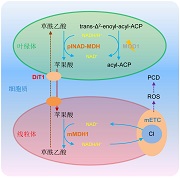

死亡信号传递: 叶绿体与线粒体间信号交流调控植物程序性细胞死亡
收稿日期: 2018-04-04
录用日期: 2018-04-16
网络出版日期: 2018-05-04
Death Signal Transduction: Chloroplast-to-Mitochondrion Communication Regulates Programmed Cell Death in Plants
Received date: 2018-04-04
Accepted date: 2018-04-16
Online published: 2018-05-04
程序性细胞死亡(PCD)是生物体受遗传调控的自主细胞死亡现象, 在植物生长发育和抵抗环境胁迫中起重要作用。PCD的发生可受线粒体中活性氧(ROS)诱导。中国科学院遗传与发育生物学研究所李家洋研究组早期的研究发现了1个拟南芥(Arabidopsis thaliana)细胞死亡突变体mod1, 并暗示植物细胞中存在叶绿体与线粒体之间的信号交流调控PCD, 但其中的具体作用机制尚不清楚。最近, 他们通过大规模筛选mod1突变体的抑制突变体, 克隆了3个新的抑制基因plNAD- MDH、DiT1和mMDH1。此3个基因分别编码质体定位的NAD依赖的苹果酸脱氢酶、叶绿体被膜定位的二羧酸转运蛋白1和线粒体定位的苹果酸脱氢酶1, 突变后都可抑制mod1中ROS的积累及PCD的发生。通过对这些基因进行深入的功能分析, 他们论证了苹果酸从叶绿体到线粒体的转运对线粒体中ROS的产生及随后PCD的诱导起重要作用。该研究拓展了我们对植物细胞中细胞器间交流的认识, 为我们深入理解植物PCD发生机制提供了新线索, 是该领域的一项突破性进展。

何光明 , 邓兴旺 . 死亡信号传递: 叶绿体与线粒体间信号交流调控植物程序性细胞死亡[J]. 植物学报, 2018 , 53(4) : 441 -444 . DOI: 10.11983/CBB18087
Programmed cell death (PCD) is an active and genetically controlled process that results in cell death in a multicellular organism. PCD plays important roles in plant development and defense and can be induced by increased reactive oxygen species (ROS) in mitochondria. Previous studies by Jiayang Li’s group in the Institute of Genetics and Developmental Biology, Chinese Academy of Sciences identified a cell death mutant, mod1, in Arabidopsis. Although the authors suggested that signal communication between chloroplast and mitochondrion contributes to PCD in mod1, the underlying mechanisms remain elusive. Recently, by screening the suppressors of mod1, they cloned three new suppressor genes, plNAD-MDH, DiT1 and mMDH1, which encode a plastid-localized NAD-dependent malate dehydrogenase, a chloroplastic dicarboxylate transporter, and a mitochondrial malate dehydrogenase, respectively. Mutations in these three genes each can suppress ROS accumulation and PCD in mod1. Functional analyses of these genes demonstrated that malate is transported from chloroplasts to mitochondria and triggers ROS generation and PCD in plant. This study expands our knowledge of intracellular communications between organelles and provides new understanding of molecular mechanisms of PCD in plants, which is an important progress in this field.

Key words: chloroplast; mitochondrion; malate; reactive oxygen species; programmed cell death
| 1 | Beers EP (1997). Programmed cell death during plant growth and development.Cell Death Differ 4, 649-661. |
| 2 | Berkemeyer M, Scheibe R, Ocheretina O (1998). A novel, non-redox-regulated NAD-dependent malate dehydrogenase from chloroplasts of Arabidopsis thaliana L. J Biol Chem 273, 27927-27933. |
| 3 | Coll NS, Epple P, Dangl JL (2011). Programmed cell death in the plant immune system.Cell Death Differ 18, 1247-1256. |
| 4 | Dickman M, Williams B, Li Y, de Figueiredo P, Wolpert T (2017). Reassessing apoptosis in plants.Nat Plants 3, 773-779. |
| 5 | Gorlach A, Bertram K, Hudecova S, Krizanova O (2015). Calcium and ROS: a mutual interplay.Redox Biol 6, 260-271. |
| 6 | Mou Z, He Y, Dai Y, Liu X, Li J (2000). Deficiency in fatty acid synthase leads to premature cell death and dramatic alterations in plant morphology.Plant Cell 12, 405-418. |
| 7 | Schuldiner M, Guo W (2015). Editorial overview: cell organe- lles: organelle communication: new means and new views. Curr Opin Cell Biol 35, v-vi. |
| 8 | Taniguchi M, Taniguchi Y, Kawasaki M, Takeda S, Kato T, Sato S, Tabata S, Miyake H, Sugiyama T (2002). Iden- tifying and characterizing plastidic 2-oxoglutarate/malate and dicarboxylate transporters in Arabidopsis thaliana. Plant Cell Physiol 43, 706-717. |
| 9 | Tomaz T, Bagard M, Pracharoenwattana I, Lindén P, Lee CP, Carroll AJ, Ströher E, Smith SM, Gardeström P, Millar AH (2010). Mitochondrial malate dehydrogenase lowers leaf respiration and alters photorespiration and plant growth in Arabidopsis. Plant Physiol 154, 1143-1157 . |
| 10 | Van Aken O, Van Breusegem F (2015). Licensed to kill: mitochondria, chloroplasts, and cell death.Trends Plant Sci 20, 754-766. |
| 11 | Van Breusegem F, Dat JF (2006). Reactive oxygen species in plant cell death.Plant Physiol 141, 384-390. |
| 12 | Wu J, Sun Y, Zhao Y, Zhang J, Luo L, Li M, Wang J, Yu H, Liu G, Yang L, Xiong G, Zhou JM, Zuo J, Wang Y, Li J (2015). Deficient plastidic fatty acid synthesis triggers cell death by modulating mitochondrial reactive oxygen species.Cell Res 25, 621-633. |
| 13 | Zhao YN, Luo LL, Xu JS, Xin PY, Guo HY, Wu J, Bai L, Wang GD, Chu JF, Zuo JR, Yu H, Huang X, Li JY (2018). Malate transported from chloroplast to mitochondrion triggers production of ROS and PCD in Arabidopsis thaliana. Cell Res 28, 448-461. |
/
| 〈 |
|
〉 |